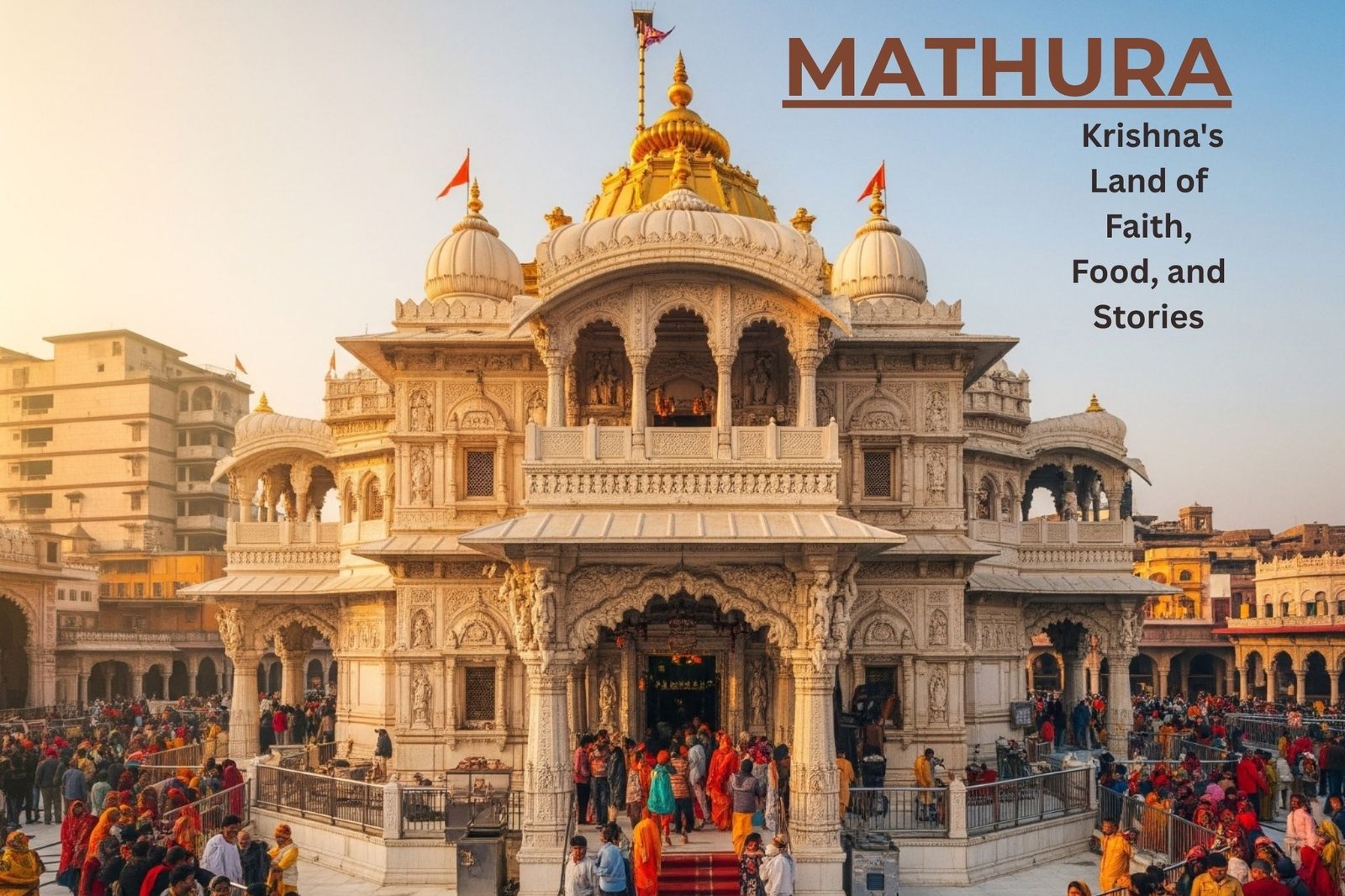Today, I take you to Mathura—a city older than memory, where gods were first given human form in stone, and where the sacred Yamuna continues to flow with the stories of Krishna. My journey here, after trips to Kishangarh and Bharatpur, was a conscious shift from the mindset of a traveler to that of a pilgrim. I came not just to see, but to feel the heartbeat of Braj Bhoomi, the land where divinity and humanity have danced together for millennia.
For those planning a visit to this spiritual heartland, here’s a quick overview. The twin cities of Mathura and Vrindavan are the epicenter. The most profound sites are the Krishna Janmabhoomi in Mathura and the ghats of the Yamuna River, especially Vishram Ghat for the evening Aarti. Be prepared for a sensory explosion at the Holi Gate market, home to legendary street food. A crucial tip for the Janmabhoomi temple: absolutely no electronic devices are allowed inside, so use the cloakroom service near the gate.
The Heart of Faith: Inside Krishna Janmabhoomi
The spiritual core of Mathura is the Krishna Janmabhoomi complex, which marks the spot where Lord Krishna is believed to have been born. Visiting this place is a lesson in faith’s resilience. After navigating high security and depositing all my belongings, I walked towards the sanctum. The actual birthplace is a small, modest, jail-like room. Standing inside that cramped, stone-walled space, stripped of all modern distractions, was incredibly powerful. You are not just in a temple; you are inside a story, a moment in mythology that has shaped the beliefs of millions. The inability to take photos felt like a blessing, forcing me to capture the memory with my heart, not my lens.
The Yamuna: A River of Rituals and Stories
My deepest connection with the region was forged on the banks of the Yamuna. I took a boat ride at dawn with Mukesh Kevat, a local boatman whose family has rowed these waters for generations. As the morning mist rose, the only sounds were the gentle splash of his oars and the distant echo of bhajans from Vishram Ghat.
Mukesh shared stories of the Chunari Manorat, a beautiful ritual where devotees offer a long, ornate sari to the river, praying to Yamuna Devi. Watching this personal expression of faith, I understood that the river here is not just a body of water; she is a living, breathing goddess, a mother to the people of Braj. The evening Aarti at Vishram Ghat, with its flickering lamps and resonant chants, felt like the city’s collective thank you to the river that sustains it.
Mathura’s Forgotten Legacy: Where Gods Got a Face
While Mathura is known for Krishna, its historical significance is even broader. A visit to the Mathura Museum is non-negotiable for any history lover. It was here, under the patronage of the Kushan and Gupta empires, that the Mathura School of Art flourished. This is one of the first places in the world where deities were given human form. Before this, gods were represented by symbols. Seeing those ancient, serene-faced sculptures of Buddha, Jain Tirthankaras, and early Hindu gods, you realize you are standing at a pivotal moment in the history of human expression and faith. This rich, cosmopolitan past, a hub for trade and multiple religions, was sadly eroded by invasions from Mahmud of Ghazni and Aurangzeb, making the surviving art even more precious.
The Flavors, Colors, and Energy of the Streets
To know Mathura is to taste it. I spent an evening walking through the chaotic, vibrant lanes near Holi Gate. The air was thick with the aroma of sizzling snacks. I tried the famous Malai Chaap and watched jalebis being fried to a perfect crisp at Rupa Kachoriwala. Each bite was an explosion of flavor. This is also where I reminisced about a past trip in 2015, when I photographed the famous Lathmar Holi in nearby Barsana—a riot of color, energy, and emotion that is impossible to forget.
An Unexpected Discovery: The Akhada Culture
Across the Yamuna, I stumbled upon a local Akhada (traditional wrestling school). Here, young men, their bodies covered in mud, practiced a form of wrestling that has been passed down for centuries. It was a surprising discovery of raw strength and discipline, a tradition of shakti (power) that exists in perfect harmony with the devotional bhakti of the temples.
A Traveler’s Guide to Mathura and Vrindavan
- Temple Rules are Strict: At Krishna Janmabhoomi and other major temples, be prepared for security checks. No phones, cameras, or leather items are allowed. Use the cloakrooms available.
- Boating on the Yamuna: The best times are early morning for a peaceful, misty ride or evening for the Aarti. Negotiate the price with your boatman beforehand and consider a tip for their stories.
- Holi Festival: If you plan to visit during Holi, be prepared. It is intense and can be overwhelming. Go with a local guide, protect your camera gear, and be respectful of the traditions.
- Prioritize the Museum: To truly understand Mathura’s importance, spend at least a few hours at the Government Museum. It provides context that enriches the entire pilgrimage.
- Stay with Locals: I stayed at the ISKCON guesthouse in Vrindavan, which was clean and spiritually immersive. Choosing a local guesthouse or homestay offers a more authentic experience.
A Final Reflection
Mathura is not just a city; it’s a canvas where gods, saints, artists, wrestlers, and commoners have all left their stories for you to find. You find them in the serene expressions of ancient sculptures, in the faith-filled eyes of a pilgrim at the ghat, and in the sweet, sticky taste of a freshly made jalebi. You come seeking the story of a god, but you leave with a deeper understanding of the human heart that has kept his story alive for millennia.

Leave a Reply